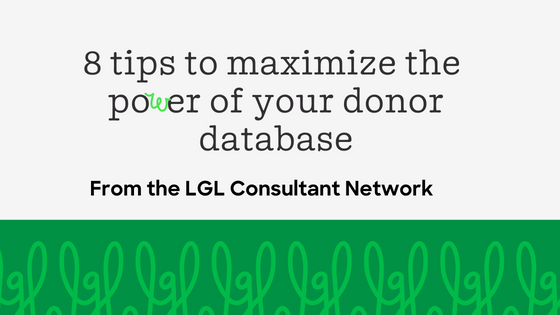Little Green Light is a cloud-based donor management system for fundraisers.
Subscribe to get our latest product updates, best practices and tips to grow your nonprofit.

With the flurry of year-end activity behind you, the members of the LGL Consultant Network have great tips that your nonprofit can implement now to ensure that you’re set up for fundraising success in the months ahead. As consultant Felicia Terry notes, when your donor management system is used to its fullest it’s a tool that lets you “analyze and engage donors and supporters in the way they want to be engaged.”
You probably didn’t have time to deal with returned envelopes in December, but you need to prioritize them in January. Update your database with information from returned envelopes, which may include address changes, marking a constituent as deceased, or marking an address as inactive. Karen Schaller notes it’s important to make those updates swiftly so that you don’t keep sending mail to old addresses. Keep an eye out for changes that are seasonal rather than permanent, however.
All the consultants agree that now is the time to do a thorough check of your database to see what needs to be cleaned up, deactivated, archived, or updated.
Some key areas to review:
Once you’ve cleaned up your data at the start of the year, commit to doing it on a quarterly basis. That way, you’ll avoid things getting too sloppy. To get into a good habit with data maintenance, Rick Eaton recommends that you make it a regular part of your schedule. Consider devoting an hour after your staff meeting to data entry and clean-up. If you struggle with prioritizing your data maintenance, consider Carrie Grote’s point that, “Your database is your #1 fundraising tool. It’s not just a place to park your gifts.”
You’ll especially benefit from good data hygiene when it’s time to report on your fundraising efforts. By ensuring that every gift record is coded with a campaign, a fund, and an event or appeal, you can ensure the accuracy of your reports. “If you only complete fields some of the time,” Kristin Whipple cautions, “you don’t know when you left it empty on purpose and when you missed it.” To ensure your gift records aren’t missing that information, you can take Kristen’s advice to create scheduled, monthly gift reports of any gift records that are missing a campaign, fund, and event or appeal.
Judith Youngblood is a big proponent of calendaring the year ahead so you can see how your staff time will ebb and flow. Include upcoming events, appeals, reports for the Board, your organization’s 990 deadline, as well as any external reports that may be due for grants. Once you’ve created your fundraising calendar, create tasks in your donor management system to help you stay on top of deadlines.
Felicia Terry observes that it’s common for organizations to not yet be fully leveraging the power of their database. But, she’s quick to note, you can change that. Deb McCann echoes this point and finds it’s productive to consider your development operations and ask yourself, “What are the pain points? What feels like it takes longer than it should? Don’t just sit with that—do something about it!” Take advantage of training opportunities, Knowledge Base instructions, and other available resources.
Your personal interactions with donors won’t serve your organization in the long run if they aren’t documented. Use contact reports in your database to document your personalized interactions with donors. Whether you create a contact report immediately after meeting with a donor, carve out time to enter them once a week, or set a monthly deadline for yourself; “be disciplined and consistent—it has to be a way that works for you,” Randy Gorod says.
James Phelps finds that for a lot of organizations, launching a planned giving program gets put on the back burner. But the beginning of the year is a great time to start putting one together. James recommends that you examine your data to find the donors who’ve made the highest number of gifts—not necessarily the most frequent gifts or the largest gifts, but the most lifetime gifts. Prioritize those top ten lifetime donors as you start your planned giving program.
And finally…
Rick Eaton urges you to take some time off, celebrate what you’ve accomplished in the prior year, and “find ways to bring joy to the job. If you don’t relax and goof off a little, you don’t become creative. Fundraising can suffer from lack of creativity.”
About LGL’s Consultant Network
While the Little Green Light support team is able to offer guidance and help troubleshoot issues in LGL accounts, LGL’s Consultant Network can assist you with longer term projects like data migrations, forms mapping, integrations, general process improvement—even LGL training! The network includes independent consultants who are experts in nonprofit data management and in Little Green Light. They are not LGL employees or contractors, but we have thoroughly vetted them. They set their own work schedules and pricing and work remotely with their customers. If you’d like more information about the LGL Consultant Network or if you’re ready to place a request, please visit https://www.littlegreenlight.com/consultants/.
Ready to try LGL? Get your first 30 days free. No credit card required.